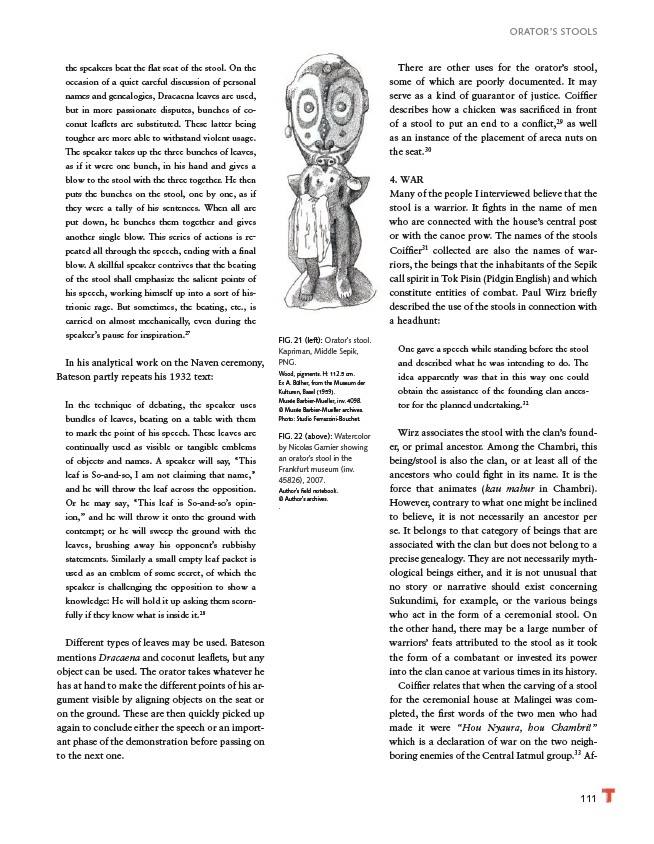
There are other uses for the orator’s stool,
some of which are poorly documented. It may
serve as a kind of guarantor of justice. Coiffier
describes how a chicken was sacrificed in front
of a stool to put an end to a conflict,29 as well
as an instance of the placement of areca nuts on
the seat.30
4. WAR
Many of the people I interviewed believe that the
stool is a warrior. It fights in the name of men
who are connected with the house’s central post
or with the canoe prow. The names of the stools
Coiffier31 collected are also the names of warriors,
the beings that the inhabitants of the Sepik
call spirit in Tok Pisin (Pidgin English) and which
constitute entities of combat. Paul Wirz briefly
described the use of the stools in connection with
a headhunt:
One gave a speech while standing before the stool
and described what he was intending to do. The
idea apparently was that in this way one could
obtain the assistance of the founding clan ancestor
111
for the planned undertaking.32
Wirz associates the stool with the clan’s founder,
or primal ancestor. Among the Chambri, this
being/stool is also the clan, or at least all of the
ancestors who could fight in its name. It is the
force that animates (kau mahur in Chambri).
However, contrary to what one might be inclined
to believe, it is not necessarily an ancestor per
se. It belongs to that category of beings that are
associated with the clan but does not belong to a
precise genealogy. They are not necessarily mythological
beings either, and it is not unusual that
no story or narrative should exist concerning
Sukundimi, for example, or the various beings
who act in the form of a ceremonial stool. On
the other hand, there may be a large number of
warriors’ feats attributed to the stool as it took
the form of a combatant or invested its power
into the clan canoe at various times in its history.
Coiffier relates that when the carving of a stool
for the ceremonial house at Malingei was completed,
the first words of the two men who had
made it were “Hou Nyaura, hou Chambri!”
which is a declaration of war on the two neighboring
enemies of the Central Iatmul group.33 Af-
FIG. 21 (left): Orator’s stool.
Kapriman, Middle Sepik,
PNG.
Wood, pigments. H: 112.5 cm.
Ex A. Bülher, from the Museum der
Kulturen, Basel (1959).
Musée Barbier-Mueller, inv. 4098.
© Musée Barbier-Mueller archives.
Photo: Studio Ferrazzini-Bouchet.
FIG. 22 (above): Watercolor
by Nicolas Garnier showing
an orator’s stool in the
Frankfurt museum (inv.
45826), 2007.
Author’s field notebook.
© Author’s archives.
.
the speakers beat the flat seat of the stool. On the
occasion of a quiet careful discussion of personal
names and genealogies, Dracaena leaves are used,
but in more passionate disputes, bunches of coconut
leaflets are substituted. These latter being
tougher are more able to withstand violent usage.
The speaker takes up the three bunches of leaves,
as if it were one bunch, in his hand and gives a
blow to the stool with the three together. He then
puts the bunches on the stool, one by one, as if
they were a tally of his sentences. When all are
put down, he bunches them together and gives
another single blow. This series of actions is repeated
all through the speech, ending with a final
blow. A skillful speaker contrives that the beating
of the stool shall emphasize the salient points of
his speech, working himself up into a sort of histrionic
rage. But sometimes, the beating, etc., is
carried on almost mechanically, even during the
speaker’s pause for inspiration.27
In his analytical work on the Naven ceremony,
Bateson partly repeats his 1932 text:
In the technique of debating, the speaker uses
bundles of leaves, beating on a table with them
to mark the point of his speech. These leaves are
continually used as visible or tangible emblems
of objects and names. A speaker will say, “This
leaf is So-and-so, I am not claiming that name,”
and he will throw the leaf across the opposition.
Or he may say, “This leaf is So-and-so’s opinion,”
and he will throw it onto the ground with
contempt; or he will sweep the ground with the
leaves, brushing away his opponent’s rubbishy
statements. Similarly a small empty leaf packet is
used as an emblem of some secret, of which the
speaker is challenging the opposition to show a
knowledge: He will hold it up asking them scornfully
if they know what is inside it.28
Different types of leaves may be used. Bateson
mentions Dracaena and coconut leaflets, but any
object can be used. The orator takes whatever he
has at hand to make the different points of his argument
visible by aligning objects on the seat or
on the ground. These are then quickly picked up
again to conclude either the speech or an important
phase of the demonstration before passing on
to the next one.
ORATOR’S STOOLS